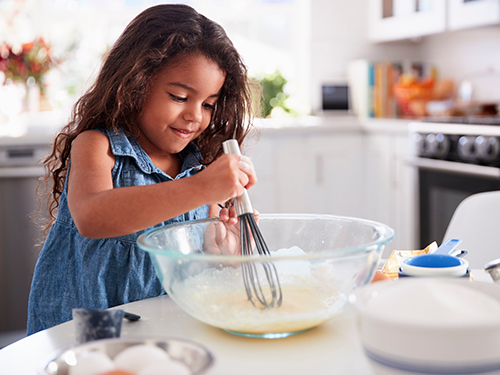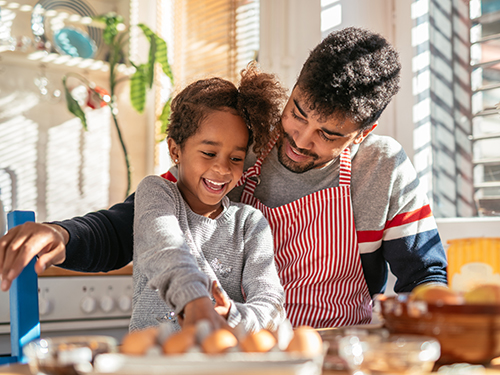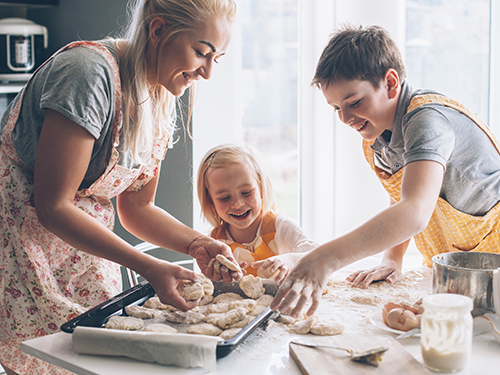
Fact Sheet FS1368
Trying to figure out how to fit making, serving, and eating a nutritious, delicious meal into your day? Want to spend more time with your kids and set them up with healthy habits for life? It can be as simple as inviting them into the kitchen to cook with you! It may seem daunting at first, but getting kids to cook early has so many benefits, for you and them. Kids who help prepare meals:
Children gain such a sense of accomplishment when they can share, "I poured the water" or "I made the salad."
And for you, an engaged child in the kitchen means a sous chef for years to come. As confidence builds, children can take on more tasks to speed up meal preparation and divide responsibilities in the household. Another added benefit is that you will have more time to chat with your kids and strengthen your relationships.
Joint cooking activities increase quality time spent with children and are a great way to encourage adventurous eaters. Cooking together can teach or reinforce lessons in a variety of topics adaptable by age and skills:
How Do I Begin?
Timing is everything!
Make sure you and your child are well rested so that everyone is less likely to get frustrated. Start with a day that is less hectic in your home; this is often a weekend meal. Start slowly and give children breaks if there is a lull in the action.
Choose recipes and tasks that reflect interests and abilities!
Start with recipes that have five or less ingredients and that they like. Be sure to have all the ingredients ready so you can focus on helping kids learn new skills.
Cooking is a skill; practice is needed!
Adults can use this time to practice planning and patience. Kids can learn new skills one at a time and build upon those skills with regular practice. If you are new to cooking, you too can learn new skills alongside your child.
Embrace the mess!
Supervision is key, but a mess may be inevitable. It is important to keep the mood light and encourage positive behaviors. Think of ways to make the most of your space and equipment, like using a larger bowl than needed to help keep ingredients contained for enthusiastic mixers.
Focus on food safety!
Create a set of house rules together and outline who is responsible for which tasks. Rules can change as skills are built. Children can have their own drawer or container of tools for them to use so that sharp utensils are separate from safe ones. Slow progression of skills and tasks will help keep everyone safe. Always follow food safety basics:
Start slowly!
Start by inviting your child into the kitchen while you cook. You can offer them tastes of ingredients and talk about the colors, scents, flavors, and textures. This can be a low-stress way to introduce new foods. Children can help select a recipe or rename a family favorite. Very young children can play with measuring spoons or cups while you cook.
How Can Children Help?
Remember, each child is unique, but you can use the following outline as a guide for engaging kids in the kitchen.
3–5-Year-Olds
While their motor skills are still developing, young ones are eager to help.
6–7-Year-Olds
Fine motor skills have developed, and they can help with more detailed work.
8–9-Year-Olds
Skills will vary, so tailor the tasks to what your child can do.
10–12-Year-Olds
This age group can work independently with less supervision. Ensure they can follow kitchen safety rules before leaving completely alone.
Working together in the kitchen can increase your child’s self-efficacy and set them up for a lifetime of healthy habits. It is important to remember that supervision is key and to start small and go slowly. Once they master some skills, kids can make great sous chefs, saving you time!
For additional resources and recipes, check out these websites:
References
- Academy of Nutrition and Dietetics. Teaching Kids to Cook. Updated October 14, 2024. Accessed November 27, 2024.
- Allirot, X, Quinta, N, Chokupermal, K, & Urdaneta, E. Involving children in cooking activities: A potential strategy for directing food choices toward novel foods containing vegetables. Appetite. 2016; 103: 275-285.
- Berge JM, MacLehose RF, Larson N, Laska M, Neumark-Sztainer D. Family Food Preparation and Its Effects on Adolescent Dietary Quality and Eating Patterns. Journal of Adolescent Health. 2016; 59(5): 530-536.
- Farmer N, Cotter EW. Well-Being and Cooking Behavior: Using the Positive Emotion, Engagement, Relationships, Meaning, and Accomplishment (PERMA) Model as a Theoretical Framework. Frontiers in Psychology. 2021;12: 560578.
- Hamner HC, Dooyema CA, Blanck HM, et al. Fruit, Vegetable, and Sugar-Sweetened Beverage Intake Among Young Children, by State — United States, 2021. Morbidity and Mortality Weekly Report. 2023; 72:165–170.
- Marsh LE, Kanngiesser P, Hood B. When and how does labour lead to love? The ontogeny and mechanisms of the IKEA effect. Cognition. 2018; 170:245-253.
- Michael SL, Jones SE, Merlo CL, et al. Dietary and Physical Activity Behaviors in 2021 and Changes from 2019 to 2021 Among High School Students — Youth Risk Behavior Survey, United States, 2021. Morbidity and Mortality Weekly Report Supplement. 2023; 72(Suppl-1):75–83.
- Radtke T, Liszewska N, Horodyska K, Boberska M, Schenkel K, Luszczynska A. Cooking together: The IKEA effect on family vegetable intake. British Journal of Health Psychology. 2019; 24(4):896-912.
- Van der Horst K, Ferrage A, Rytz A. Involving children in meal preparation. Effects on food intake. Appetite. 2014; 79:18-24.
April 2025
Copyright © 2025 Rutgers, The State University of New Jersey. All rights reserved.
For more information: njaes.rutgers.edu.
Cooperating Agencies: Rutgers, The State University of New Jersey, U.S. Department of Agriculture, and Boards of County Commissioners. Rutgers Cooperative Extension, a unit of the Rutgers New Jersey Agricultural Experiment Station, is an equal opportunity program provider and employer.



